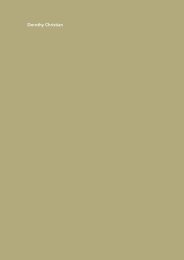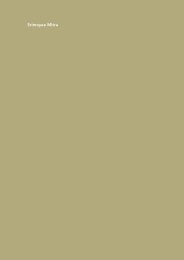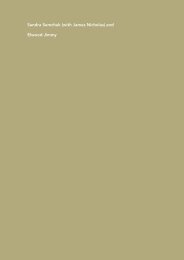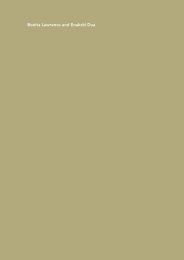Shirley Bear - Speaking My Truth
Shirley Bear - Speaking My Truth
Shirley Bear - Speaking My Truth
- No tags were found...
Create successful ePaper yourself
Turn your PDF publications into a flip-book with our unique Google optimized e-Paper software.
had another girl, and named her Ramona. Peter and I decided to homeschoolher. When Ramona was seven years old we settled in Negootkook, NewBrunswick.It was then that I started to realize that I had a keen understanding of injusticeand that I was basically fearless, which helped in making decisions andaddressing the government of Canada on their treatment of the First Nations’women in my community.Sandra Lovelace-Nicholas was testing the government of Canada for the sexistclause 12(1)b within the Indian Act, a law that governed the daily lives of FirstNations who lived on reserve land.In 1985, the women from Negootkook (Tobique) celebrated the elimination of12(1)b from the Indian Act of Canada. The publication of a book titled Enoughis Enough: Aboriginal Women Speak Out, which chronicles the adult lives ofthirteen women from Negootkook, told our stories.3Ashok:I was not privy to <strong>Shirley</strong>’s years prior to Enough is Enough, but her rallying crybehind the Minquon Panchayat made it clear she had come to such culturalactivism with the depth and wisdom of experience. The Minquon Panchayatworked with ANNPAC for that first year, bringing its energy and dedicationto an incredible showcase of talent and potential to the It’s a Cultural Thinggathering in Calgary in 1993. But it was here many of us realized that progressiveaction does not win over conservative histories easily. During a formationalmeeting at the Native Friendship Centre where ANNPAC was discussing theMinquon Panchayat’s provisional plan for realignment, some felt the prescribedaction of moving quickly to bring in new member organizations was far tooswift, an affront to those, I suggest, who wanted change to be more cosmeticthan radical. At one point, a frustrated ANNPAC executive member voiceddissent at the proposed changes, saying that the organization was alreadymaking progressive moves as it had allowed the Minquon Panchayat to presentthis prospectus. I can still hear <strong>Shirley</strong>’s voice as she raised first her eyebrows,and then her entire body from the seated circle. “Allow?” she asked. “Youallowed us?” And without another word, <strong>Shirley</strong> slowly walked along the outsideof the circle, with no more than a glance to her colleagues, enough to haveus all rise as one and follow her upstairs. There, she led us in a healing circle,and when some of our number wondered whether we could still reconcileand salvage something from this situation, <strong>Shirley</strong>, so calmly smudging withsweetgrass, shook her head. No, she told us, this was not the time. Only that.And that was all she needed to say for the rest to understand.Cultivating Canada | 19
<strong>Shirley</strong>:When Annie Mae Pictou-Aquash was killed at Pine Ridge, it was an assault toall the women of the world. She had always been very outspoken for the rightsof women; and to have this happen to her in Pine Ridge, the home (temple)of the some of the most male-dominated spiritualists in the First Nationscommunity, was an outright insult to womanhood.In the years of the Native Women’s Rights battle, many changes developedin me through art. It was reconfirmed by past teachings that women, as lifegivers,had a special place in the community, and, in my case, as decisionmakerswithin the family, community, and country.In my forties, I went on a spiritual quest and found more insidious rulesand sexist activities against women. All supposedly because of the laws ofKisiulinaqô (in the name of god), and because my language is not written, Ihad never read or heard of such rules. I fasted for several years and prayedto be given the truth, but as each year went by I was more convinced thatthere were no such rules and that they were pretty much a warped creationof men who did not want women to attain a spiritual understanding. Thesemen were brainwashed by the Catholic Church.<strong>My</strong> art speaks the truth of its creator.Ashok:Years later, I saw <strong>Shirley</strong> <strong>Bear</strong> on stage engaged in dialogue with writerSusan Crean. They were playing out a biography of Emily Carr (ironicallyenough, in the lecture theatre of the Vancouver art school named for thatartist) that Crean had written. It explored various lesser documentedelements, most notably Carr’s friendship with Aboriginal artist Sophie Frankfrom whom, Crean argued, Carr had learned a great deal about Aboriginalpeople of the West Coast. Here, Susan Crean played Emily Carr, <strong>Shirley</strong> <strong>Bear</strong>played Sophie Frank, and the retelling spoke volumes about the relationshipsamong women, art, and culture, across land and across time. I remember<strong>Shirley</strong> telling me soon after that she thoroughly enjoyed reading thecreative works of younger women of colour in Canada, for they spoke ofwhat was possible. It brought to mind the healing circle of all those yearsbefore when <strong>Shirley</strong> rightly reminded us that change can and must happen,but we had to listen to our hearts as much as to our heads.20 | <strong>Shirley</strong> <strong>Bear</strong>
<strong>Shirley</strong> <strong>Bear</strong>, Nil ewik’husi, (Self-portrait) (2006)Ink wash on hand pulled paper, 24 x 18.5 cmCultivating Canada | 21
<strong>Shirley</strong>:Circle around,beautifulbrown womenBeautiful brownwomenDrum singing for the womenOwl eyes hey yehey yaRed tableclothyellow lamp burning.Red mind singing,yellow love burningbeautifulbrown women4Notes1 See Gagnon, Monika Kin (2000:63). Other Conundrums: Race, Culture, and CanadianArt. Vancouver and Kamloops, BC: Arsenal Pulp Press, Artspeak Gallery, and theKamloops Art Gallery.2 Crean, Susan (2009: 37). N’tow’wik’hegat (She Who Knows How to Make Pictures). In T.Graff (curator), Nekt wikuhpon ehpit (Once there lived a woman): The Painting, Poetry,and Politics of <strong>Shirley</strong> <strong>Bear</strong>. Fredericton, NB: Beaverbrook Art Gallery.3 Silman, Janet (ed.) (1987). Enough is Enough: Aboriginal Women Speak Out. Toronto,ON: The Women’s Press.4 Excerpted from the poem, “Dawn.” In <strong>Shirley</strong> <strong>Bear</strong> (2006:20–21). Virgin Bones: BelayakKcikug’nas’ikn’ug. Toronto, ON: McGilligan Books.22 | <strong>Shirley</strong> <strong>Bear</strong>
















